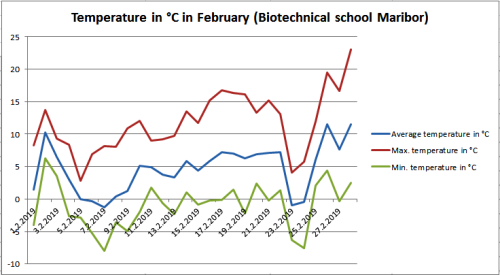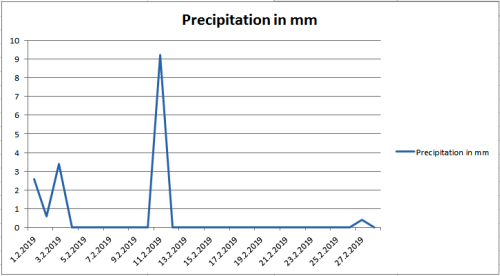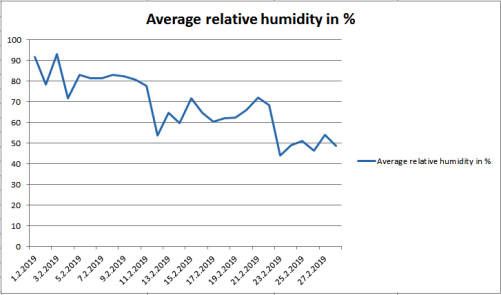Freitag, 15. März 2019
Meteorological report for February (Maribor)
beekids, 10:35h
Are climate change really not happening? Weather conditions are changing rapidly, especially when compared to long-term measurements. This February was a real contradiction to last year's. February 2018 showed us that it is truly a winter month. This year, it's spring.
The difference between the highest (28th February) and the lowest (7th February) measured temperature in the month was as high as 31 °C. From this, we can understand, that we had cold nights and mornings and too high daily temperatures.
The average monthly temperature was much higher than the average of the period from 1981 to 2010, it was 4,7 °C, and it was 3 °C higher than the long-term average. By comparison, in February 2018, the average temperature was - 1.41 °C (6.11 °C lower). The long-term average for February is 1.7 °C in Maribor. If we compare only the average temperature of the second half of the month with the average period from 1981 to 2010, we can see that it was higher by 4.53 °C.
In February, the average temperature was only five times below the freezing point (0 °C). The maximum temperature did not reach even the freezing point. The minimum temperature was nine times above the freezing point. The lowest temperature in February was - 8 °C, and the highest temperature was 23 °C. Compared to February 2018, the lowest temperature was - 20.2 °C and the highest was 11.58 °C.

Precipitation data show that the trend of falling precipitation is still continuing. There was no snow fall at all, therefore drought is expected in March, especially in cereals (barley, wheat).
In February there was less precipitation than a long-term average. The measuring device detected only 16.2 mm of precipitation, and the long-term average is 38 mm precipitation. Most precipitation dropped in the first half of the month. In February 2018, dropped 78.6 mm of precipitation and 106.8 cm of snow.

The average relative humidity in February was 67.85 %, which is even less than in January. In February 2018 it was as much as 86.42 %.

The difference between the highest (28th February) and the lowest (7th February) measured temperature in the month was as high as 31 °C. From this, we can understand, that we had cold nights and mornings and too high daily temperatures.
The average monthly temperature was much higher than the average of the period from 1981 to 2010, it was 4,7 °C, and it was 3 °C higher than the long-term average. By comparison, in February 2018, the average temperature was - 1.41 °C (6.11 °C lower). The long-term average for February is 1.7 °C in Maribor. If we compare only the average temperature of the second half of the month with the average period from 1981 to 2010, we can see that it was higher by 4.53 °C.
In February, the average temperature was only five times below the freezing point (0 °C). The maximum temperature did not reach even the freezing point. The minimum temperature was nine times above the freezing point. The lowest temperature in February was - 8 °C, and the highest temperature was 23 °C. Compared to February 2018, the lowest temperature was - 20.2 °C and the highest was 11.58 °C.

Precipitation data show that the trend of falling precipitation is still continuing. There was no snow fall at all, therefore drought is expected in March, especially in cereals (barley, wheat).
In February there was less precipitation than a long-term average. The measuring device detected only 16.2 mm of precipitation, and the long-term average is 38 mm precipitation. Most precipitation dropped in the first half of the month. In February 2018, dropped 78.6 mm of precipitation and 106.8 cm of snow.

The average relative humidity in February was 67.85 %, which is even less than in January. In February 2018 it was as much as 86.42 %.

... comment